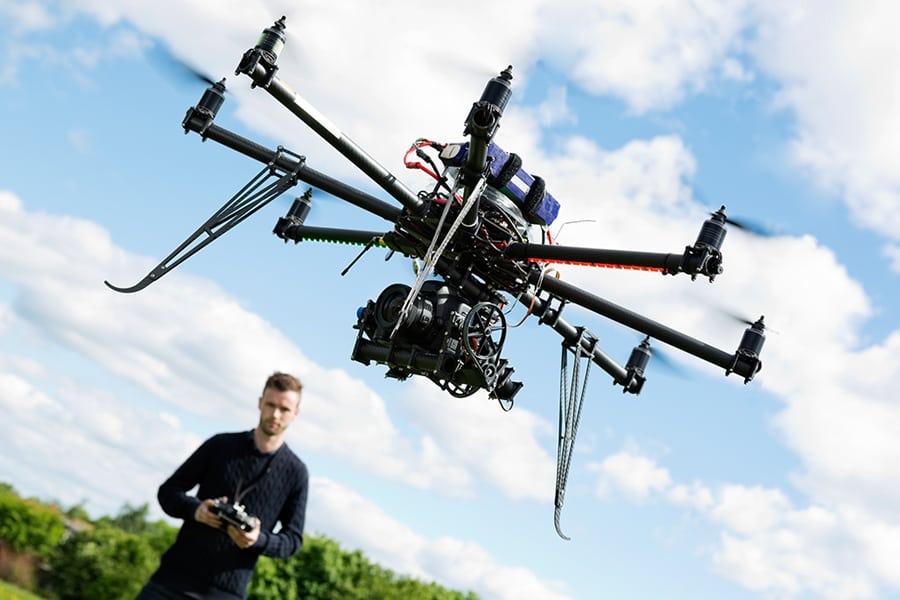[Avionics Today 12-15-2014] With Unmanned Aircraft Vehicles (UAVs) sneaking steadily into commercial use across the globe for large and small businesses alike, Transport Canada is looking to ease the process by relaxing rules for business small UAV use. The Canadian transportation authority has taken steps in this direction by introducing two new weight-based exemptions for small UAVs that aim to make it simpler for businesses to legally operate the devices commercially. Now, under the new exemptions, operators flying UAVs categorized as very small, less than 2 kg, or small, between 2 kg and 25 kg, for business purposes will no longer require a Special Operations Certificate (SOC) to do so.
 |
| Operator flying small UAS. Photo: Transport Canada |
“The new exemptions help address the rapid growth in this sector and safely integrate unmanned aircraft into civil airspace,” said Martin Eley, director general of civil aviation at Transport Canada, in a written statement to Avionics Magazine. “In June 2010, Transport Canada created a UAV working group with industry stakeholders to recommend key changes to the existing regulations. Their recommendations informed the new exemptions and will help Transport Canada develop new UAV regulations in the future that continue to promote growth and innovation, while ensuring the safety of those on the ground and in the skies.”
Eley stresses that operators who fall under the new exemptions must still adhere to the safety conditions Transport Canada has laid out, including height restrictions, minimum distances from people and property, and flight within visual line-of-sight. Canada has been instituting safety regulations on UAVs since 1996, but the new relaxed rules will help reduce the red tape businesses have to deal with when gaining authorization for more complex operations and, ultimately, fuel new use cases and technology for unmanned aircraft in both public and private sectors.
“Canada has been looking at [Unmanned Aircraft Systems] UAS for a long time now and have actually been utilizing this technology in the public safety realm for some time,” said Melanie Hinton, senior communications manager at the Association for Unmanned Vehicle Systems International (AUVSI) in a written interview with Avionics Magazine. “They have a couple of cases on record where they have found lost hikers and motorists who have gone off road by utilizing UAS. These regulations make Canada one of the most UAS-friendly and progressive country [sic] in the world. Their regulations are quite effective and close to what the industry in the U.S. has been asking for of the FAA.”
The FAA is expected to release UAS regulations and a roadmap to integrate the new technology into the United States’ National Airspace System (NAS) — a notably complicated task — as early as next year. In the meantime, the FAA has been offering exemptions to certain businesses under Section 333 for commercial UAS use in areas such as movie production, aerial surveying and the monitoring of construction sites. Operators and businesses are hoping the American agency will follow suit with Canadian ruling to introduce eased regulations when they emerge, especially since the impact of the fledgling commercial UAS industry is set to leave its mark on the economy.
“The integration of unmanned aircraft into the U.S. airspace will create thousands of jobs and generate billions of dollars in economic activity and tax revenue,” Hinton noted, citing an economic impact study conducted by AUVSI in 2013. “Meanwhile, the benefits of the integration will be felt immediately — with the most substantial benefits coming in the first three years following the full integration.” The specifics of the study forecast that the new UAS industry will generate more than $82 billion in revenue and 100,000 jobs, many of them high-paying positions, by 2025.
To those involved, however, the impact on the economy seems secondary to the ways that UAS can influence commercial, public and private lives on the day-to-day in the very foreseeable future.
“UAS are truly an evolutionary technology,” Hinton said. “Whatever dull, dirty, dangerous or difficult job you can think of, UAS can help businesses do the job more effectively and efficiently. The applications are endless! We have talked a lot about UAS being utilized for agriculture and public safety, but you can also add in filmmaking, hazmat detection, power line monitoring, gas pipeline monitoring, construction, mining, mapping, natural disaster damage assessment, environmental research, pollution monitoring, arctic research, sporting events, the list is literally endless.”